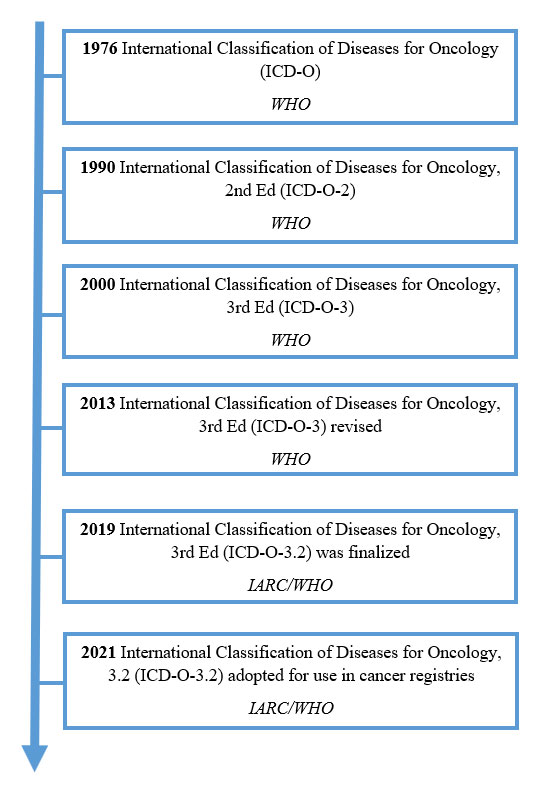Introduction
Historical Background of the International Classification of Diseases for Oncology
The International Classification of Diseases for Oncology (ICD-O) is a multi-axial classification of the site, morphology, behavior, and grading of neoplasms. ICD-O is used principally in tumor or cancer registries for coding the site (topography) and the histology (morphology) of neoplasms, usually obtained from a pathology report.
In 1976, the World Health Organization (WHO) published the first edition of ICD-O, which included a topography section based on the malignant neoplasm rubrics of ICD-9 and a morphology section based on the American Cancer Society (ACS) Manual of Tumor Nomenclature and Coding (MOTNAC).
In 1990, WHO published the Second Edition of ICD-O (ICD-O-2) for use in cancer registries. ICD-O-2 remained a dual classification and coding system for both topography and morphology. ICD-O-2 was used to classify cases diagnosed on January 1, 1992 through December 31, 2000. The topography codes used the same three- and four-character categories as ICD-10 for malignant neoplasms (C00-C80).
The 21st century ushered in the publication of the Third Edition of the ICD-O (ICD-O-3). The ICD-O-3 was revised with many changes occurring for lymphomas and leukemias. ICD-O-3 continued the dual classification for both topography and morphology. The topography codes did not change from those in ICD-O-2. ICD-O-3 was used in cancer registries throughout the world beginning with cancers diagnosed on January 1, 2001.
In 2013, WHO published the ICD-O-3, First Revision (ICD-O-3.1). This revision was not adopted for use in US cancer registries.
In 2019, the International Agency for Research on Cancer (IARC) and the WHO ICD-O committee, finalized ICD-O-3.2. Beginning with cases diagnosed 1/1/2021, ICD-O-3.2 is the preferred coding reference manual and is recommended to be used jointly with the 2021 ICD-O Histology and Behavior Code Update tables, Solid Tumor rules, and Hematopoietic and Lymphoid Neoplasm Database.
Errata and Updates
Two sets of errata have been released for ICD-O-3. They are archived on the SEER website, https://seer.cancer.gov/archive/icd-o-3/
ICD-O-3 updates (2001, 2003, 2011) are also available from WHO at: https://www.who.int/standards/classifications/other-classifications/international-classification-of-diseases-for-oncology
ICD-O-3 is no longer published in print form. Web versions and updates are available at http://www.iacr.com.fr/
IARC provides an electronic version of ICD-O-3 on their website, http://www.iacr.com.fr/. However, the IARC versions are not identical to the versions used in the U.S. See the ICD-O-3 errata on the SEER website and the NAACCR ICD-O-3 implementation guidelines for U.S. instructions, https://www.naaccr.org/icdo3/
ICD-O lineage

Timeline of ICD-O
Updated: December 13, 2023
Suggested Citation
SEER Training Modules: Introduction. U.S. National Institutes of Health, National Cancer Institute. Cited 20 January 2026. Available from: https://training.seer.cancer.gov.




